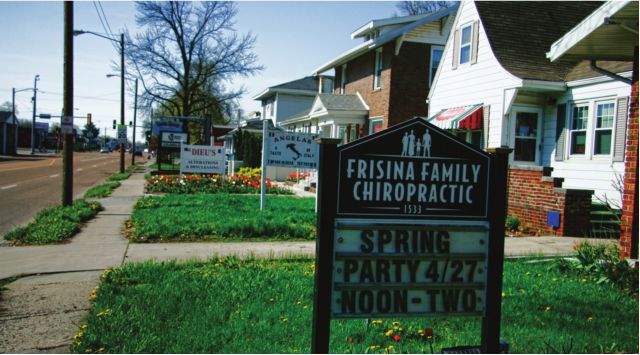
Keeping Springfield weird
Some visitors to Springfield don’t like what they see
DYSPEPSIANA | James Krohe Jr.
No parent ever has an ugly baby. Even if the little darling has a head that looks like a cantaloupe from the bottom of the pile, parents don’t like strangers stating the obvious. People are the same way about their hometowns.
Back in March, the SJ-R’s Dave Bakke gallantly strode forward to defend Springfield against sneers about her looks from cheeky strangers. One of these was a traveler who recently passed through and wrote, “The streets were fairly empty and the town pretty dead. It was pretty to look at, but it seemed like they were waiting for tourists or something. It was a weird city, but pretty beautiful.” Some weeks previous to that, a Cook County Republican official damned Springfield as a “dreary and sad town.”
So what’s new? In 2007, journalist Andrew Ferguson found Springfield to be a “clapped out old burg.” In 2005, Bill Bryson – on the road looking for the perfect American town – concluded in The Lost Continent that Springfield wasn’t it, finding it “neither offensive or charming,” which means pretty much nothing much at all. And in 2002, the visiting Regional/ Urban Design Assistance Team observed that the Statehouse complex – the only part of town that many visitors see – was “dominated by appallingly ugly parking lots and desultory, boring, low-bidder office buildings.”
The vocabulary that most Americans apply to places seldom extends much beyond new and old, pretty and ugly. The words used in most of these recent libels, however, are much more interesting. Weird. Dreary. Sad. Clapped out. Desultory.
What, exactly, inspires this poetic disdain? In my first 40 years, during which time I scarcely ever left Springfield even overnight, I wouldn’t have been able to say; I grew up in Springfield, and familiar faults soon become invisible faults. But returning to Springfield after years spent living in other places, I finally was able to see what I had learned to ignore before I left.
MacArthur Boulevard south of South Grand is a good example. Driving into an American city for the first time by car, you expect to see houses and small apartment buildings on quiet side streets, and
commercial districts along busy, wider thoroughfares. Land use zoning is
near-universal in this country and that is how zoning arrays such
buildings on the land. This street however is lined with a random
scattering of houses, office buildings and shops. (See “A little bit of a
challenge” Nov. 4, 2010.) Springfield long ago zoned every property on
every street that’s too wide to spit across as appropriate for
commercial uses, giving it vastly more commercial land than there will
ever be commercial establishments to occupy it. Having ceased long ago
to be residential because of commercial intrusions, MacArthur will never
become fully office or commercial, but remains something less than
either.
If the block
is half-commercial and halfresidential, so are a lot of the buildings,
because of the promiscuous conversion of many of those houses into
shops. The identity of every aspect of these blocks, in fact, seems to
be mutable, and almost shifts before your eyes. Overpaving has blurred
the familiar distinctions between street and curb, curb and parkway,
parkway and sidewalk, sidewalk and parking lot. For visitors accustomed
to the more ordered environments of other cities, such a streetscape is
incoherent, and they react to it with confusion and unease. No wonder
people find it weird.
Planners
and citizens have complained for years about the excessive number of
surface parking lots in both downtown Springfield and along its
neighborhood commercial strips. These half-empty lots are unpleasant to
look at, certainly, especially in their unadorned state, but it is not
its looks that so often strikes a visitor driving along a street like
Wabash east of Chatham Road. Nor is she thinking, “Oh, how convenient!”
She’s thinking, “This town has nothing better to do with its land.”
In
addition to storing cars in the city’s front yard, as it were, there is
the local aesthetic. City officials demand very little of local
developers, too many of whom usually strive to give them even less. The
result is prefabs in the heart of the city that one usually sees on
farmsteads, and new apartment buildings that look like the cages I used
to keep captive critters in when I was a boy – shoeboxes with holes
punched in the sides. On too many projects does the signage, landscaping
and site design look like the work of people who find any way but the
quickest, simplest and cheapest to be beyond them. No wonder people
think the place looks tired, dreary, clapped out, desultory.
So
the next time you get steamed when some bum blows through town tossing
insults from the car window, remember Henry Mencken. His stock reply to
readers who were critical of him was, “Dear Sir (or Madame), You may be
right.”
Contact James Krohe Jr. at [email protected].
Editor’s note
The
drama over Springfi eld schools continues, with interim superintendent
Robert Leming apologizing to parents of Capital College Preparatory
Academy students for leaked test scores and the board accepting
resignations from staff members who did the leaking. See Patrick
Yeagle’s report on page 8. Now Leming continues his peacemaking role by
organizing a “Springfi eld Public Schools Good Will Tour” on May 2, to
show community leaders “some of the great things in our district.” OK,
but let’s not overdo the hangdog act. Most of us never understood the
leaked test scores controversy, because the leak never went very far.
Convening a new school board will go a long way toward building confi
dence, and hiring a new superintendent will create some excitement.
Reversing the decision to close CCPA will go farther than apologies.
Restoring state funding cuts to schools is what really needs to happen.
–Fletcher Farrar, editor and publisher